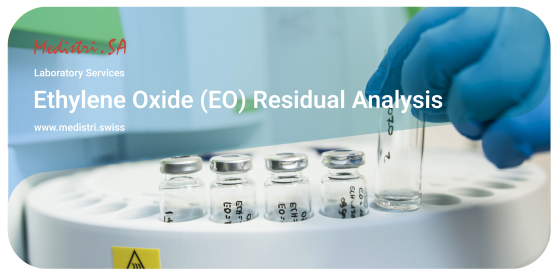(Download: Ethylene Oxide Residual Analysis by Medistri in PDF)
It is critical to make sure that the levels of residual ethylene oxide, ethylene chlorohydrin (ECH), and ethylene glycol (EG) represent the least amount of harm to the patient during routine product usage when evaluating the suitability of ethylene oxide for sterilization of medical equipment.
👉 Because of its broad material compatibility, ethylene oxide (EO) is frequently used to sterilize medical equipment. It’s possible for EO to leave a residue on the material being sterilized. The following are the residues that may remain following sterilisation:
- Ethylene Oxide (EO) is a possible byproduct of processing.
- Ethylene Chlorohydrin (ECH) is a potential by product of EO’s interaction with free chloride ions.
- Ethylene Glycol (EG), a byproduct that may result from the interaction of EO with water.
The categories of medical devices that have been identified are based on the duration they are used on the final patients and will determine the maximum allowable levels of such EO residues in the final device. The ISO 10993–7 (2008) on Biological evaluation of medical devices — Part 7: Ethylene oxide sterilization residuals is the guiding document generally accepted for the evaluation of EO residuals in medical devices.
For the assessment of EO residuals in medical devices, this guideline documents the authorized limit of each residue, the suggested technique of extracting and testing the residues, and comprehensive quality control on the analytical procedure.
ISO 10993–7:2008(E): Biological evaluation of medical devices — Part 7: Ethylene oxide sterilization residuals. Thermolabile medical devices are generally sterilised by exposure to ethylene oxide. Any surplus ethylene oxide will be removed during the aeration phase. Afterwards, the products must be tested for ethylene oxide residues. The reliable quality control of medical devices is, as a result, a requirement for production that corresponds to international standards as well as for the successful marketing of your products.
❓ Why perform Ethylene Oxide Residual Analysis:
After performing an ethylene oxide sterilization process, a device may still contain considerable concentration of residues for a variety of causes.
- Material: Some compounds will absorb and hold onto gas molecules more so than others. Natural compounds with high absorption capacities include cellulose and cotton. Some plastic materials have also demonstrated a high rate of absorption when subjected to EO processing.
- Packaging: Breathable packaging, such Tyvek or medical-grade paper, are necessary for EO processing in order to let gas molecules to flow through. The gas won’t be able to penetrate the breathable barrier as effectively if the packaging has a restricted or blocked surface area (like a big sticky label).
- Volume, density, and general load arrangement of the load on a pallet can all be considered.
Medistri performs Ethylene Oxide (EO) residual analysis using the gas chromatography method (GC/FID). This method allows for the reliable and scalable quantification of:
✅ Ethylene Oxide residues
✅ Ethylene Glycol residues
✅ Ethylene Chlorohydrin residues
Medistri will perform ethylene Oxide Residual Analysis in our GMP Accredited In-House laboratory in Switzerland (also certified with ISO 17025) to analyse and demonstrate the safety of your sterile medical device.
Medistri has fully integrated its Sterilisation infrastructure with its laboratory infrastructure, you can now fully integrate the development of your products within your existing operational workflow. Allowing you to simplify your supply chain management and focus on growth.
🎯 To learn more about our Ethylene Oxide Residual Analysis services visit on our website at www.medistri.swiss or directly contact our team at contact@medistri.swiss.
- The Medistri Team
